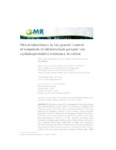Por favor, use este identificador para citar o enlazar este ítem:
http://www.alice.cnptia.embrapa.br/alice/handle/doc/1065802Registro completo de metadatos
| Campo DC | Valor | Lengua/Idioma |
|---|---|---|
| dc.contributor.author | OLIVEIRA, M. A. C. | pt_BR |
| dc.contributor.author | DUARTE, J. B. | pt_BR |
| dc.contributor.author | MORELLO, C. de L. | pt_BR |
| dc.contributor.author | SUASSUNA, N. D. | pt_BR |
| dc.contributor.author | OLIVEIRA, A. B. | pt_BR |
| dc.date.accessioned | 2017-03-02T11:11:11Z | pt_BR |
| dc.date.available | 2017-03-02T11:11:11Z | pt_BR |
| dc.date.created | 2017-03-02 | pt_BR |
| dc.date.issued | 2016 | pt_BR |
| dc.identifier.citation | Genetics and Molecular Research, v. 15, n. 3, Sept. 2016. | pt_BR |
| dc.identifier.uri | http://www.alice.cnptia.embrapa.br/alice/handle/doc/1065802 | pt_BR |
| dc.description | Ramulosis is one of the most aggressive diseases in cotton, and understanding the genetic control of its resistance is imperative for selecting superior cotton genotypes in breeding programs. This study analyzed the inheritance pattern of this resistance using chi-square goodness-of-fit tests to determine the phenotypic proportions of the F2 generation, and a mixed inheritance approach to jointly model major gene and polygenes effects. F1, F2, Rc1, and Rc2 generations were obtained by crossing resistant (BRS Facual, CNPA 2984, or CNPA 2043) and susceptible (Delta Opal, CNPA 999, or CNPA 2161) genotypes, and were assessed under field conditions with artificial inoculation of the pathogen (Colletotrichum gossypii var. cephalosporioides). Genetic control of the trait varied among the crossings. For Delta Opal x BRS Facual and CNPA 2161 x BRS Facual, phenotypic segregations in the F2 generation did not differ from the expected proportions for the hypothesis of duplicate genes (15:1). For Delta Opal x CNPA 2043, thesegregation did not differ from the expected proportions for dominant recessive epistasis (13:3). The hypothesis of genetic control by one major gene was supported only for the Delta Opal x CNPA 2043 crossing. Three other crossings showed evidence of polygenes in the inheritance of the trait. In conclusion, major genes and polygenes are likely involved in the genetic control of ramulosis resistance in cotton. | pt_BR |
| dc.language.iso | eng | eng |
| dc.rights | openAccess | eng |
| dc.subject | Genetic control | pt_BR |
| dc.title | Mixed inheritance in the genetic control of ramulosis (Colletotrichum gossypii var. cephalosporioides) resistance in cotton. | pt_BR |
| dc.type | Artigo de periódico | pt_BR |
| dc.date.updated | 2017-03-02T11:11:11Z | pt_BR |
| dc.subject.thesagro | Controle genético | pt_BR |
| dc.subject.thesagro | Colletotrichum gossypii | pt_BR |
| dc.subject.thesagro | Gossypium hirsutum | pt_BR |
| dc.subject.nalthesaurus | Cotton | pt_BR |
| riaa.ainfo.id | 1065802 | pt_BR |
| riaa.ainfo.lastupdate | 2017-03-02 | pt_BR |
| dc.contributor.institution | AGÊNCIA GOIANA DE DEFESA AGROPECUÁRIA, Itumbiara, GO; UFGO; CAMILO DE LELIS MORELLO, CNPA; NELSON DIAS SUASSUNA, CNPA; AGÊNCIA GOIANA DE DEFESA AGROPECUÁRIA, Itumbiara, GO. | pt_BR |
| Aparece en las colecciones: | Artigo em periódico indexado (CNPA)  | |
Ficheros en este ítem:
| Fichero | Descripción | Tamaño | Formato | |
|---|---|---|---|---|
| Mixedinheritanceinthegeneticcontrol.pdf | 345,65 kB | Adobe PDF |  Visualizar/Abrir |









